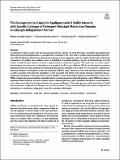Por favor, use este identificador para citar o enlazar a este item:
http://hdl.handle.net/10261/282570COMPARTIR / EXPORTAR:
 SHARE SHARE
 CORE
BASE CORE
BASE
|
|
| Visualizar otros formatos: MARC | Dublin Core | RDF | ORE | MODS | METS | DIDL | DATACITE | |

| Título: | The neuroprotective lipocalin apolipoprotein D stably interacts with specific subtypes of detergent-resistant membrane domains in a basigin-independent manner |
Autor: | Corraliza-Gómez, Miriam; Caño-Espinel, Manuela del CSIC ORCID CVN; Sánchez, Diego CSIC ORCID CVN; Ganfornina, M. D. CSIC ORCID CVN | Palabras clave: | Neuroprotection Lipid rafts Plasma membrane Lysosome Lipid peroxidation Endocytosis |
Fecha de publicación: | 2022 | Editor: | Springer Nature | Citación: | Molecular neurobiology 59: 4015-4029 (2022) | Resumen: | Accumulated evidence points to the lipocalin apolipoprotein D (ApoD), one of the few genes consistently upregulated upon brain ageing and neurodegeneration, as an endogenous controller of the redox state of cellular and extracellular lipid structures. This biochemical function has downstream consequences as apparently varied as control of glycocalyx and myelin compaction, cell viability upon oxidative stress or modulation of signalling pathways. In spite of this knowledge, it is still unclear if ApoD function requires canonical receptor-mediated transductions systems. This work aims to examine ApoD-cell membrane interaction and its dependence on a proposed ApoD receptor, Basigin. Whole and fractionated membrane preparations from the brain, primary astrocytes, glial and neuronal cell lines, reveal ApoD as a very specific component of particular subtypes of detergent-resistant microdomains (DRMs). ApoD interacts in vitro with neuronal membranes and is stably associated with astrocytic membranes. ApoD associates with DRMs with specific buoyancy properties that co-fractionate with plasma or late-endosome-lysosome markers. A mass spectrometry analysis reveals that these Triton X-114 DRMs contain both plasma membrane and endosomal-lysosomal compartment lipid raft proteins. ApoD-DRM association is maintained under metabolic and acute oxidative stress conditions. However, ApoD-membrane interaction, its internalization and its lipid-antioxidant function do not require the presence of Basigin. This work supports a stable association of ApoD with membranes, independent of Basigin, and provides the basis to fully understand ApoD antioxidant neuroprotective mechanism as a mechanism taking place in specific membrane subdomains. | Versión del editor: | http://dx.doi.org/10.1007/s12035-022-02829-z | URI: | http://hdl.handle.net/10261/282570 | DOI: | 10.1007/s12035-022-02829-z | Identificadores: | doi: 10.1007/s12035-022-02829-z issn: 0893-7648 e-issn: 1559-1182 |
| Aparece en las colecciones: | (IBGM) Artículos |
Ficheros en este ítem:
| Fichero | Descripción | Tamaño | Formato | |
|---|---|---|---|---|
| Neuroprotective Lipocalin_Corraliza_PV_Art2022.pdf | 6,07 MB | Adobe PDF |  Visualizar/Abrir |
CORE Recommender
SCOPUSTM
Citations
3
checked on 18-abr-2024
WEB OF SCIENCETM
Citations
3
checked on 22-feb-2024
Page view(s)
27
checked on 19-abr-2024
Download(s)
30
checked on 19-abr-2024
Google ScholarTM
Check
Altmetric
Altmetric
Este item está licenciado bajo una Licencia Creative Commons

